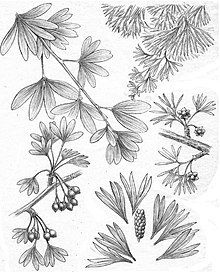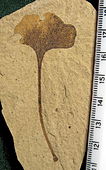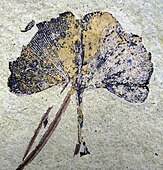
A gametophyte is one of the two alternating multicellular phases in the life cycles of plants and algae. It is a haploid multicellular organism that develops from a haploid spore that has one set of chromosomes. The gametophyte is the sexual phase in the life cycle of plants and algae. It develops sex organs that produce gametes, haploid sex cells that participate in fertilization to form a diploid zygote which has a double set of chromosomes. Cell division of the zygote results in a new diploid multicellular organism, the second stage in the life cycle known as the sporophyte. The sporophyte can produce haploid spores by meiosis that on germination produce a new generation of gametophytes.
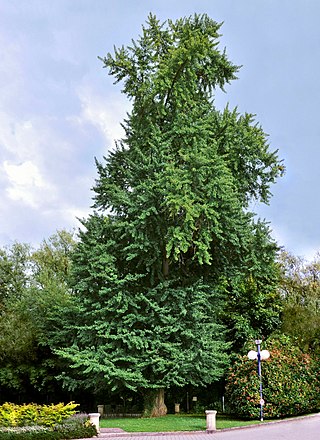
Ginkgo biloba, commonly known as ginkgo or gingko, also known as the maidenhair tree, is a species of gymnosperm tree native to East Asia. It is the last living species in the order Ginkgoales, which first appeared over 290 million years ago, and fossils very similar to the living species, belonging to the genus Ginkgo, extend back to the Middle Jurassic epoch approximately 170 million years ago. The tree was cultivated early in human history and remains commonly planted, and is widely regarded as a living fossil.

Conifers are a group of cone-bearing seed plants, a subset of gymnosperms. Scientifically, they make up the division Pinophyta, also known as Coniferophyta or Coniferae. The division contains a single extant class, Pinopsida. All extant conifers are perennial woody plants with secondary growth. The great majority are trees, though a few are shrubs. Examples include cedars, Douglas-firs, cypresses, firs, junipers, kauri, larches, pines, hemlocks, redwoods, spruces, and yews. As of 2002, Pinophyta contained seven families, 60 to 65 genera, and more than 600 living species.

The gymnosperms are a group of seed-producing plants that includes conifers, cycads, Ginkgo, and gnetophytes, forming the clade Gymnospermae. The term gymnosperm comes from the composite word in Greek: γυμνόσπερμος, literally meaning 'naked seeds'. The name is based on the unenclosed condition of their seeds. The non-encased condition of their seeds contrasts with the seeds and ovules of flowering plants (angiosperms), which are enclosed within an ovary. Gymnosperm seeds develop either on the surface of scales or leaves, which are often modified to form cones, or on their own as in yew, Torreya, Ginkgo. Gymnosperm lifecycles involve alternation of generations. They have a dominant diploid sporophyte phase and a reduced haploid gametophyte phase which is dependent on the sporophytic phase. The term "gymnosperm" is often used in paleobotany to refer to all non-angiosperm seed plants. In that case, to specify the modern monophyletic group of gymnosperms, the term Acrogymnospermae is sometimes used.

Nageia is a genus of conifers belonging to the podocarp family Podocarpaceae. Nageia includes evergreen shrubs and trees, from one to 54 meters in height. A 2009 treatment of the genus recognized five species. Some authors consider Nageia formosensis to be a separate species from Nageia nagi, thus recognizing six species. The podocarp genera have been reshuffled by various botanists. Most recently, several species formerly classed as Nageia were moved to the new genus Retrophyllum, while Nageia falcata and Nageia mannii were moved to the new genus Afrocarpus.

Afrocarpus is a genus of conifers of the family Podocarpaceae. Two to six species are recognized. They are evergreen trees native to Africa. Afrocarpus was designated a genus in 1989, when several species formerly classified in Podocarpus and Nageia were reclassified.

Bennettitales is an extinct order of seed plants that first appeared in the Permian period and became extinct in most areas toward the end of the Cretaceous. Bennettitales were amongst the most common seed plants of the Mesozoic, and had morphologies including shrub and cycad-like forms. The foliage of bennettitaleans is superficially nearly indistinguishable from that of cycads, but they are distinguished from cycads by their more complex flower-like reproductive organs, at least some of which were likely pollinated by insects.

Torreya is a genus of conifers comprising six or seven species placed in the family Taxaceae, though sometimes formerly placed in Cephalotaxaceae. Four species are native to eastern Asia; the other two are native to North America. They are small to medium-sized evergreen trees reaching 5–20 m, rarely 25 m, tall. Common names include nutmeg yew.
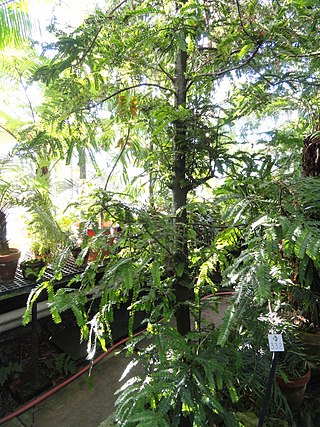
Retrophyllum is a genus of conifers in the family Podocarpaceae. It contains five generally recognized extant species with a disjunct distribution in the Southern Hemisphere, found in Papuasia and also in South America. Retrophyllum are evergreen trees typically occurring in tropical rainforests and cloud forests.

Cephalotaxus, commonly called plum yew or cowtail pine, is a genus of conifers comprising 11 species, either considered the only member of the family Cephalotaxaceae, or in the Taxaceae when that family is considered in a broad sense. The genus is endemic to eastern Asia, though fossil evidence shows it had a wider Northern Hemisphere distribution in the past. The species are evergreen shrubs and small trees reaching 1.0–10 metres (3–33 ft) tall.

Trochodendraceae is the only family of flowering plants in the order Trochodendrales. It comprises two extant genera, each with a single species along with up to five additional extinct genera and a number of extinct species. The living species are native to south east Asia. The two living species both have secondary xylem without vessel elements, which is quite rare in angiosperms. As the vessel-free wood suggests primitiveness, these two species have attracted much taxonomic attention.

Dioon is a genus of cycads in the family Zamiaceae. It is native to Mexico and Central America. Their habitats include tropical forests, pine-oak forest, and dry hillsides, canyons and coastal dunes.
A strobilus is a structure present on many land plant species consisting of sporangia-bearing structures densely aggregated along a stem. Strobili are often called cones, but some botanists restrict the use of the term cone to the woody seed strobili of conifers. Strobili are characterized by a central axis surrounded by spirally arranged or decussate structures that may be modified leaves or modified stems.
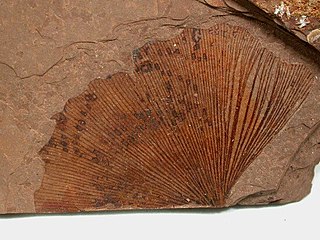
Ginkgo is a genus of non-flowering seed plants. The scientific name is also used as the English name. The order to which it belongs, Ginkgoales, first appeared in the Permian, 270 million years ago, and Ginkgo is now the only living genus within the order. The rate of evolution within the genus has been slow, and almost all its species had become extinct by the end of the Pliocene. The sole surviving species, Ginkgo biloba, is found in the wild only in China, but is cultivated around the world. The relationships between ginkgos and other groups of plants are not fully resolved.

Ginkgo dissecta is an extinct ginkgo species in the family Ginkgoaceae described from a series of isolated fossil leaves. The species is known from Early Eocene sediments exposed in the province of British Columbia, Canada, and Washington, US. It is one of two Ginkgo species found at the Washington and British Columbia sites.
Acer stewarti is an extinct maple species in the family Sapindaceae described from a series of fossil leaves and samaras. The species is solely known from the Early Eocene sediments exposed in south central British Columbia, Canada adjacent to northeast Washington state, United States. It is one of only two species belonging to the extinct section Stewarta.

Ginkgo huttonii is an extinct Ginkgo species in the family Ginkgoaceae from the Jurassic of England. The fossil is also known by the name, Ginkgoites huttonii, the genus, Ginkgoites, referring to a group of extinct members of the Ginkgoaceae. G. huttonii was a broad-leaved, deciduous gymnosperm bearing resemblance to the only living member of the Ginkgoaceae, Ginkgo biloba.
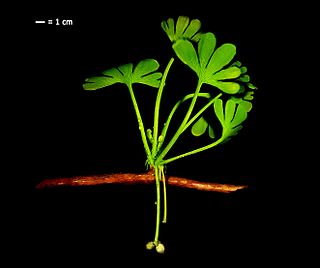
Ginkgo apodes is an extinct species of plant in the order Ginkgoales. It is known from fossils found in the Yixian Formation dated to the Tithonian period, from the Late Jurassic, located near Mount Yinwoshan, Yixian region, Liaoning Province, China.

Yimaia is an extinct genus of Ginkgoalean tree, and the only member of the family Yimaiaceae. In botanical form classification, its a form taxon for ginkgoalean ovulate organs. Yimaia species are distinguished from other Ginkgoales by the presence of "Ovulate organs consisting of a peduncle and up to eight or nine terminal, sessile, contiguous and orthotropous ovules." The ovules are associated with leaves of either Baiera or Ginkgoites leaf morphospecies. Fossils have been found in Middle Jurassic deposits in China.

Baiera is a genus of prehistoric gymnosperms in the order Ginkgoales. It is one of the oldest fossil foliage types of Ginkgoales, and is related to the genera Ginkgo and Ginkgoites. Fossils of Baiera are found worldwide, and have been known from the Permian to the Cretaceous.
